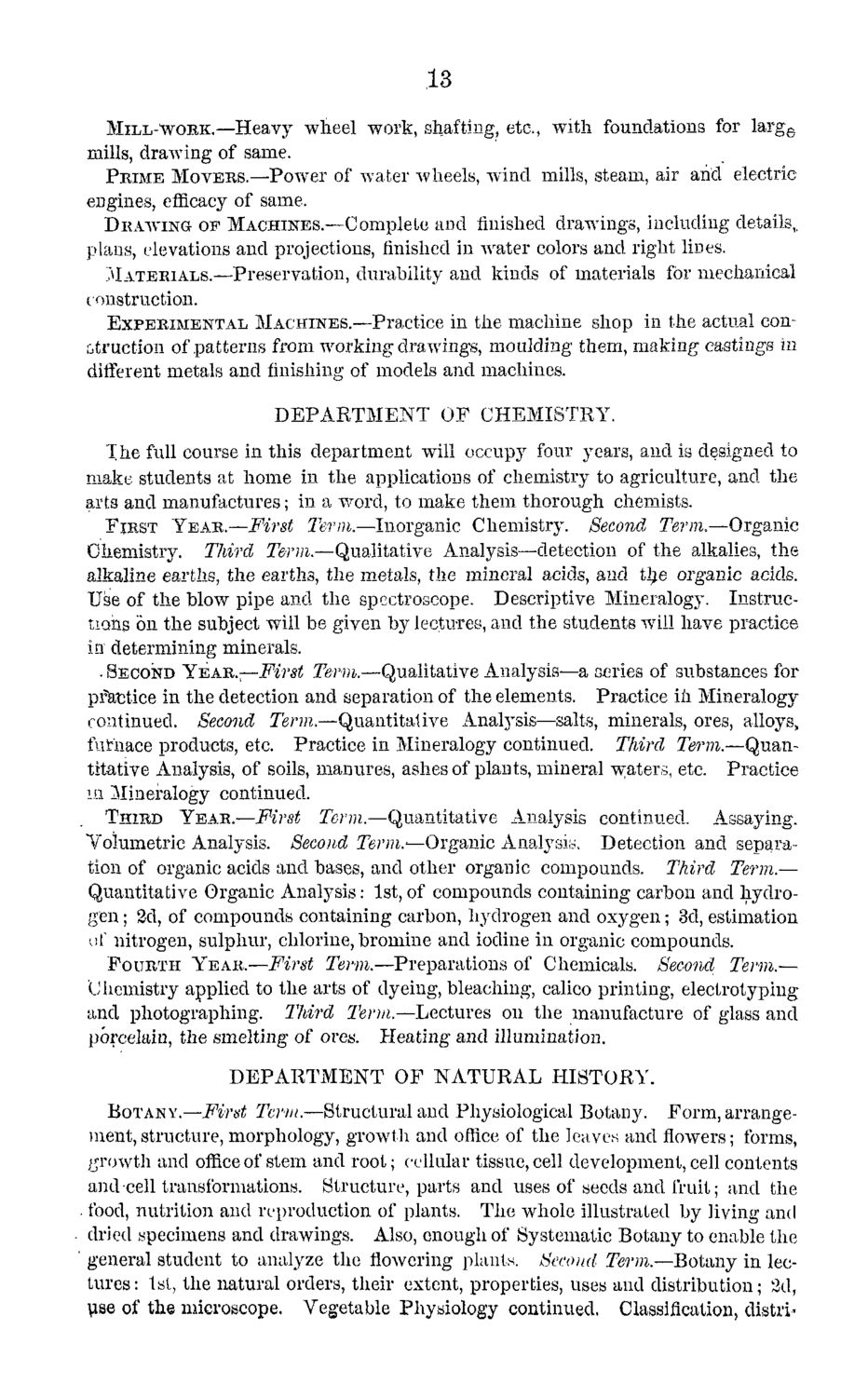| |
| |
Caption: Course Catalog - 1869-1870
This is a reduced-resolution page image for fast online browsing.

EXTRACTED TEXT FROM PAGE:
13 MILL-WORK.—Heavy wheel work, shafting, etc., with foundations for larg 6 mills, drawing of same. PRIME MOVERS.—Power of water wheels, wind mills, steam, air arid electric engines, efficacy of same. DRAWING OF MACHINES.—Complete and finished drawings, including details,, plans, elevations and projections, finished in water colors and right lines. MATERIALS.—Preservation, durability and kinds of materials for mechanical construction. EXPERIMENTAL MACHINES.—Practice in the machine shop in the actual construction of patterns from working drawings, moulding them, making castings in different metals and finishing of models and machines. DEPARTMENT OF CHEMISTRY. The full course in this department will occupy four years, and is designed to make students at home in the applications of chemistry to agriculture, and the arts and manufactures; in a word, to make them thorough chemists. FIRST TEAR.—First Term.—Inorganic Chemistry. Second Term,—Organic Chemistry. Third Term.—Qualitative Analysis—detection of the alkalies, the alkaline earths, the earths, the metals, the mineral acids, and the organic acids. Use of the blow pipe and the spectroscope. Descriptive Mineralogy. Instructions on the subject will be given by lectures, and the students will have practice in determining minerals. • SECOND YEAR.;—First Term.—Qualitative Analysis—a series of substances for pfattice in the detection and separation of the elements. Practice in Mineralogy continued. Second Term,—Quantitative Analysis—salts, minerals, ores, alloys, furnace products, etc. Practice in Mineralogy continued. Third Term.—Quantitative Analysis, of soils, manures, ashes of plants, mineral waters, etc. Practice HI Mineralogy continued. THIRD YEAR.—First Term.—Quantitative Analysis continued. Assaying. Volumetric Analysis. Second Term.'—Organic Analysis. Detection and separation of organic acids and bases, and other organic compounds. Third Term.— Quantitative Organic Analysis: 1st,of compounds containing carbon and hydrogen ; 2d, of compounds containing carbon, hydrogen and oxygen; 3d, estimation of nitrogen, sulphur, chlorine, bromine and iodine in organic compounds. FOURTH YEAR.—First Term.—Preparations of Chemicals. Second Term.— 'Chemistry applied to the arts of dyeing, bleaching, calico printing, electrotyping and photographing. Third Term.—Lectures on the manufacture of glass and porcelain, the smelting of ores. Heating and illumination. DEPARTMENT OF NATURAL HISTORY. BOTANY.—First Term.—Structural and Physiological Botany. Form, arrangement, structure, morphology, growth and office of the leaves and flowers; forms, growth and office of stem and root; cellular tissue, cell development, cell contents and cell transformations. Structure, parts and uses of seeds and fruit; and the . food, nutrition and reproduction of plants. The whole illustrated by living and dried specimens and drawings. Also, enough of Systematic Botany to enable the ' general student to analyze the flowering plants. Second Term.—Botany in lectures: tat, the natural orders, their extent, properties, uses and distribution; 3d, use of the microscope. Vegetable Physiology continued. Class!fleation, distri-
| |